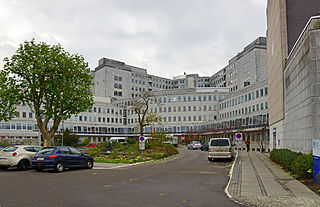
H. Lundbeck A/S, commonly referred to as Lundbeck, is a Danish international pharmaceutical company engaged in the research, development, manufacturing, marketing and sale of pharmaceuticals across the world. The company’s products are targeted at brain diseases, including depression, schizophrenia, Alzheimer's disease, Parkinson's disease and migraine.

Cerebral amyloid angiopathy (CAA) is a form of angiopathy in which amyloid beta peptide deposits in the walls of small to medium blood vessels of the central nervous system and meninges. The term congophilic is sometimes used because the presence of the abnormal aggregations of amyloid can be demonstrated by microscopic examination of brain tissue after staining with Congo red. The amyloid material is only found in the brain and as such the disease is not related to other forms of amyloidosis.

Neuropsychiatry is a branch of medicine that deals with psychiatry as it relates to neurology, in an effort to understand and attribute behavior to the interaction of neurobiology and social psychology factors. Within neuropsychiatry, the mind is considered "as an emergent property of the brain", whereas other behavioral and neurological specialties might consider the two as separate entities. Those disciplines are typically practiced separately.

Desmoteplase is a novel, highly fibrin-specific "clot-busting" (thrombolytic) drug in development that reached phase III clinical trials. The Danish pharmaceutical company, Lundbeck, owns the worldwide rights to Desmoteplase. In 2009, two large trials were started to test it as a safe and effective treatment for patients with acute ischaemic stroke. After disappointing results in DIAS-3, DIAS-4 was terminated, and in December 2014 Lundbeck announced that they would stop the development of desmoteplase.

Neuroimaging is the use of quantitative (computational) techniques to study the structure and function of the central nervous system, developed as an objective way of scientifically studying the healthy human brain in a non-invasive manner. Increasingly it is also being used for quantitative research studies of brain disease and psychiatric illness. Neuroimaging is highly multidisciplinary involving neuroscience, computer science, psychology and statistics, and is not a medical specialty. Neuroimaging is sometimes confused with neuroradiology.
Niels Alexander Lassen was a Danish nuclear medicine physician, neurologist and pioneer in the fields of neuroimaging, neuropsychiatry and nuclear medicine. He was born and died in Copenhagen.
Olaf Bjarne Paulson is a Danish neuroscientist.

Transferrin receptor protein 1 (TfR1), also known as Cluster of Differentiation 71 (CD71), is a protein that in humans is encoded by the TFRC gene. TfR1 is required for iron import from transferrin into cells by endocytosis.

Droxidopa, also known as L-threo-dihydroxyphenylserine (L-DOPS) and sold under the brand names Northera and Dops among others, is sympathomimetic medication which is used in the treatment of hypotension and for other indications. It is taken by mouth.

Rigshospitalet Glostrup is hospital located in the township of Glostrup, 8 km from the center of Copenhagen in Denmark. It is owned and managed by the regional health authority of the Greater Copenhagen region, Region Hovedstaden. The hospital was formerly known as Glostrup Hospital, but after the merger with Rigshospitalet 1/1/2015, it is now known as Rigshospitalet Glostrup.

Albert Gjedde: is a Danish-Canadian neuroscientist. He is Professor of Neurobiology and Pharmacology at the Faculty of Health Sciences and Center of Neuroscience at the University of Copenhagen. He is currently also Adjunct Professor of Neurology and Neurosurgery in the Department of Neurology, Montreal Neurological Institute, McGill University, Montreal, Quebec, Canada, Adjunct Professor of Radiology and Radiological Science in the Division of Nuclear Medicine, Department of Radiology and Radiological Science, Johns Hopkins University, Baltimore, Maryland, US, Adjunct Professor of Translational Neuropsychiatry Research, University of Southern Denmark, Odense, Denmark, and adjunct professor of psychiatry at Tabriz University of Medical Sciences, Tabriz, East Azerbadjan, Iran.
Alzheimer's Disease Neuroimaging Initiative (ADNI) is a multisite study that aims to improve clinical trials for the prevention and treatment of Alzheimer's disease (AD). This cooperative study combines expertise and funding from the private and public sector to study subjects with AD, as well as those who may develop AD and controls with no signs of cognitive impairment. Researchers at 63 sites in the US and Canada track the progression of AD in the human brain with neuroimaging, biochemical, and genetic biological markers. This knowledge helps to find better clinical trials for the prevention and treatment of AD. ADNI has made a global impact, firstly by developing a set of standardized protocols to allow the comparison of results from multiple centers, and secondly by its data-sharing policy which makes available all at the data without embargo to qualified researchers worldwide. To date, over 1000 scientific publications have used ADNI data. A number of other initiatives related to AD and other diseases have been designed and implemented using ADNI as a model. ADNI has been running since 2004 and is currently funded until 2021.
The European College of Neuropsychopharmacology (ECNP) is a pan-European, non-profit scientific association that serves as a platform to exchange and promote research in the field of neuropsychopharmacology. The ECNP “is committed to ensuring that advances in the understanding of brain function and human behaviour are translated into better treatments and enhanced public health”. The ECNP organises a number of activities to achieve this aim, such as a yearly congress, workshops, seminars, New Frontiers Meetings, publications, awards, supported talks and much more.
The following outline is provided as an overview of and topical guide to brain mapping:

Andreas Kjær is a Danish physician-scientist and European Research Council (ERC) advanced grantee. He is professor at the University of Copenhagen and chief physician at Rigshospitalet, the National University Hospital of Denmark. He is board certified in Nuclear Medicine and his research is focused on molecular imaging with PET and PET/MRI and targeted radionuclide therapies (theranostics) in cancer. His achievements include development of several new PET tracers that have reached first-in-human clinical use. He has published more than 400 peer-review articles, filed 10 patents, supervised more than 40 PhD students and received numerous prestigious scientific awards over the years. He is a member of the Danish Academy of Technical Sciences

Messoud Ashina is a Danish-Azerbaijani neurologist and neuroscientist. He is currently Professor of Neurology at the University of Copenhagen and Senior Consultant of Neurology at Copenhagen University Hospital - Rigshospitalet. He leads the Human Migraine Research Unit at the Danish Headache Center, Copenhagen University Hospital - Rigshospitalet. Ashina is also Director of the Danish Knowledge Center on Headache Disorders and Past President of the International Headache Society. As of 2024, Ashina is ranked as the world's leading expert on headache disorders by Expertscape.

Wolfgang Löscher is a Professor in the Department of Pharmacology, Toxicology, and Pharmacy at the University of Veterinary Medicine Hannover, Germany and also a member of the National Academy of Sciences Leopoldina.

Martin Johannes Lauritzen is a Danish neuroscientist. He is a Professor of Translational Neurobiology at the Department of Neuroscience, University of Copenhagen, Denmark and also a Professor of Clinical Neurophysiology at the Department of Neurophysiology, Rigshospitalet.
Martina F. Callaghan is an Irish medical physicist who is the Director of the Wellcome Centre for Human Neuroimaging at the UCL Queen Square Institute of Neurology. Her research considers the development of in-vivo histology using MRI.
A cerebroprotectant is a drug that is intended to protect the brain after the onset of acute ischemic stroke. As stroke is the second largest cause of death worldwide and a leading cause of adult disability, over 150 drugs have been tested in clinical trials to provide cerebroprotection.












